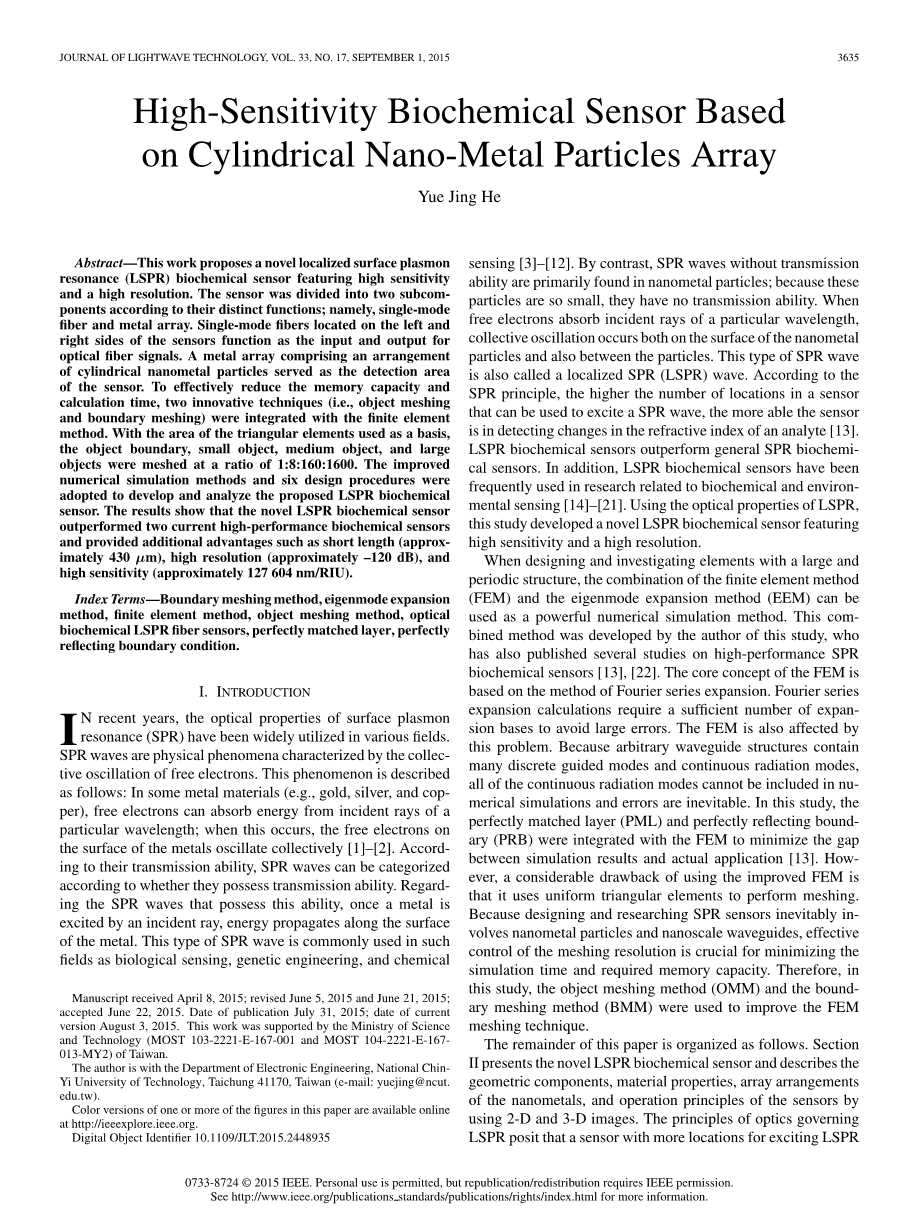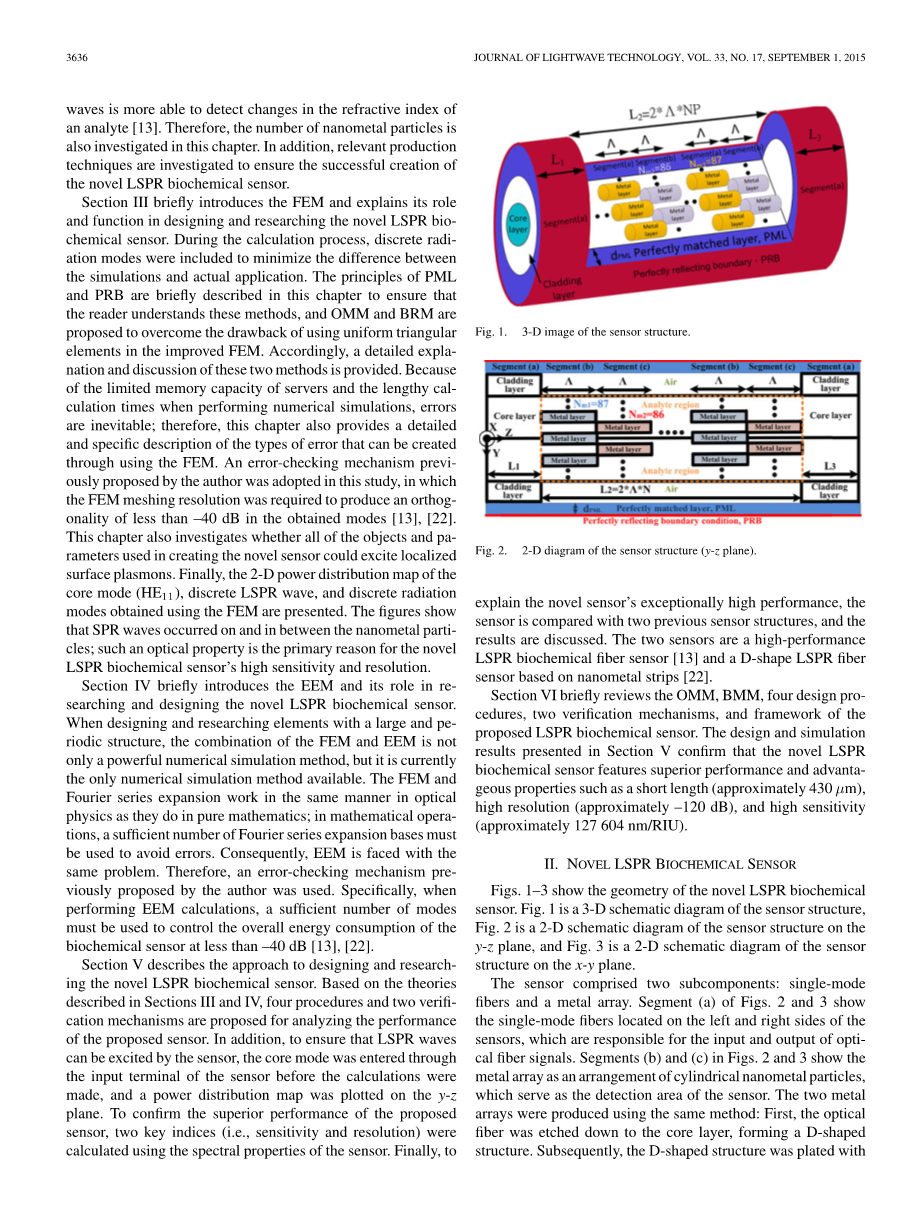

英语原文共 8 页,剩余内容已隐藏,支付完成后下载完整资料
High-Sensitivity Biochemical Sensor Based on Cylindrical Nano-Metal Particles Array
Yue Jing He
Abstract—This work proposes a novel localized surface plasmon resonance (LSPR) biochemical sensor featuring high sensitivity and a high resolution. The sensor was divided into two subcomponents according to their distinct functions; namely, single-mode fiber and metal array. Single-mode fibers located on the left and right sides of the sensors function as the input and output for optical fiber signals. A metal array comprising an arrangement of cylindrical nanometal particles served as the detection area of the sensor. To effectively reduce the memory capacity and calculation time, two innovative techniques (i.e., object meshing and boundary meshing) were integrated with the finite element method. With the area of the triangular elements used as a basis, the object boundary, small object, medium object, and large objects were meshed at a ratio of 1:8:160:1600. The improved numerical simulation methods and six design procedures were adopted to develop and analyze the proposed LSPR biochemical sensor. The results show that the novel LSPR biochemical sensor outperformed two current high-performance biochemical sensors and provided additional advantages such as short length (approximately 430 mu;m), high resolution (approximately –120 dB), and high sensitivity (approximately 127 604 nm/RIU).
Index Terms—Boundary meshing method, eigenmode expansion method, finite element method, object meshing method, optical biochemical LSPR fiber sensors, perfectly matched layer, perfectly reflecting boundary condition.
- INTRODUCTION
IN recent years, the optical properties of surface plasmon resonance (SPR) have been widely utilized in various fields. SPR waves are physical phenomena characterized by the collective oscillation of free electrons. This phenomenon is described as follows: In some metal materials (e.g., gold, silver, and copper), free electrons can absorb energy from incident rays of a particular wavelength; when this occurs, the free electrons on the surface of the metals oscillate collectively [1]–[2]. According to their transmission ability, SPR waves can be categorized according to whether they possess transmission ability. Regarding the SPR waves that possess this ability, once a metal is excited by an incident ray, energy propagates along the surface of the metal. This type of SPR wave is commonly used in such fields as biological sensing, genetic engineering, and chemical sensing [3]–[12]. By contrast, SPR waves without transmission ability are primarily found in nanometal particles; because these particles are so small, they have no transmission ability. When free electrons absorb incident rays of a particular wavelength, collective oscillation occurs both on the surface of the nanometal particles and also between the particles. This type of SPR wave is also called a localized SPR (LSPR) wave. According to the SPR principle, the higher the number of locations in a sensor that can be used to excite a SPR wave, the more able the sensor is in detecting changes in the refractive index of an analyte [13]. LSPR biochemical sensors outperform general SPR biochemical sensors. In addition, LSPR biochemical sensors have been frequently used in research related to biochemical and environmental sensing [14]–[21]. Using the optical properties of LSPR, this study developed a novel LSPR biochemical sensor featuring high sensitivity and a high resolution.
When designing and investigating elements with a large and periodic structure, the combination of the finite element method (FEM) and the eigenmode expansion method (EEM) can be used as a powerful numerical simulation method. This combined method was developed by the author of this study, who has also published several studies on high-performance SPR biochemical sensors [13], [22]. The core concept of the FEM is based on the method of Fourier series expansion. Fourier series expansion calculations require a sufficient number of expansion bases to avoid large errors. The FEM is also affected by this problem. Because arbitrary waveguide structures contain many discrete guided modes and continuous radiation modes, all of the continuous radiation modes cannot be included in numerical simulations and errors are inevitable. In this study, the perfectly matched layer (PML) and perfectly reflecting boundary (PRB) were integrated with the FEM to minimize the gap between simulation results and actual application [13]. However, a considerable drawback of using the improved FEM is that it uses uniform triangular elements to perform meshing. Because designing and researching SPR sensors inevitably involves nanometal particles and nanoscale waveguides, effective control of the meshing resolution is crucial for minimizing the simulation time and required memory capacity. Therefore, in this study, the object meshing method (OMM) and the boundary meshing method (BMM) were used to improve the FEM meshing technique.
The remainder of this paper is organized as follows. Section II presents the novel LSPR biochemical sensor and describes the geometric components, material properties, array arrangements of the nanometals, and operation principles of the sensors by using 2-D and 3-D images. The principles of optics governing LSPR posit that a sensor with more locations for exciting LSPR waves is more able to detect changes in the refractive index of an analyte [13]. Therefore, the number of nanometal particles is also investigated in this chapter. In addition, relevant production techniques are investigated to ensure the successful creation of the novel LSPR biochemical sensor.
Section III briefly introduces the FEM and explains its role and function in designing and researching the novel LSPR biochemical sensor. During the calculation process, discrete radiation modes were included to
剩余内容已隐藏,支付完成后下载完整资料
资料编号:[604055],资料为PDF文档或Word文档,PDF文档可免费转换为Word
以上是毕业论文外文翻译,课题毕业论文、任务书、文献综述、开题报告、程序设计、图纸设计等资料可联系客服协助查找。


